
/storage.evrimagaci.org%2Ftpg%2Fdae8af6d-da66-42f4-83fa-da3a43be1d20.jpeg)



On January 17, 2025, the US Federal Aviation Administration (FAA) grounded SpaceX's Starship following a mishap during a test flight on January 16, 2025, where the upper stage disintegrated [04fbc0ae]. This incident marks a significant setback for SpaceX, as the Starship is integral to Elon Musk's ambitions for Mars colonization and NASA's Artemis lunar missions [04fbc0ae]. The FAA has mandated that SpaceX conduct a 'mishap investigation' to determine corrective actions before the rocket can return to flight [04fbc0ae].
Fortunately, the FAA confirmed that no public injuries occurred during the incident; however, they are currently assessing potential property damage in the Turks and Caicos Islands [04fbc0ae]. This was Starship's seventh orbital test and involved an upgraded version of the rocket, which had previously seen success in catching the first stage booster with its launch tower's 'chopstick' arms [04fbc0ae].
In a related context, NASA recently awarded SpaceX an $843 million contract to assist in the decommissioning of the International Space Station (ISS) [9b36859a] [c968451e]. This contract involves constructing a vehicle to safely deorbit the ISS into the Pacific Ocean, ensuring that the station's descent is controlled and minimizes risks to populated areas [20fd39be]. The ISS is set to be decommissioned by the end of 2030, paving the way for private companies to take the lead in future space station operations [2a192335] [9b36859a].
The grounding of the Starship comes at a critical time as NASA is focusing on transitioning to commercial space stations and deep space exploration, with SpaceX playing a pivotal role in both initiatives [2a192335] [9b36859a]. As the investigation unfolds, the implications for SpaceX's future missions and its partnership with NASA will be closely monitored by industry experts and space enthusiasts alike [04fbc0ae].